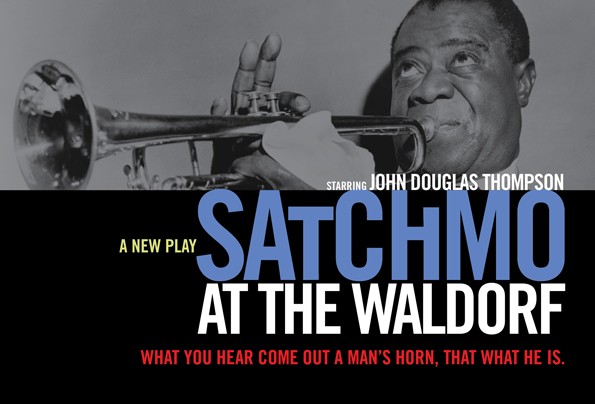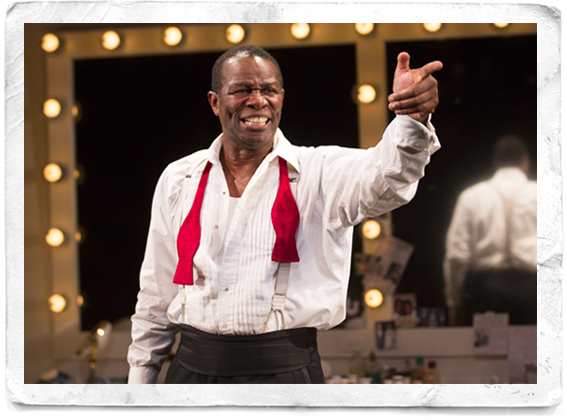

There is the smiling Louis Armstrong of popular legend, trumpet in hand, ubiquitous hanky, singing "Hello, Dolly!" in his iconic gravelly voice. There is also jazz giant Louis Armstrong, “a walking Smithsonian Institution of jazz.” Both are Louis Armstrong, an open, gregarious man who accepted the role of singer and entertainer and was proud of his jazz chops. He was a man who made compromises in life, an entertainer beloved by the people until the end, but hurt and angered by criticism and disrespect, especially from those of his own race.
At the Westside Theater, critic and writer Terry Teachout delivers a colorful, gritty look at the memorable jazzman, in Satchmo at the Waldorf, a one-man tour-de-force by John Douglas Thompson (Othello, The Emperor Jones). This March 1971 gig in the Waldorf Astoria Hotel's Empire Room will be Satchmo's last public performance before his death four months later. The voice of the announcer at the Waldorf is heard offstage, "Ladies and gentlemen…that was Louie Armstrong and his All Stars! Louie Armstrong!"
Armstrong never liked being called "Louie." He preferred "Louis," saying, "The announcer here, he call me “Louie” every night before the show. That’s O.K., call me what you want, but I ain’t no goddamn Frenchman, ain’t no Creole, ain’t no 'Lou-ie.' I’m black. Blackas a spade flush. Woke up black this morning, black when I go to bed, still gonna be black when I get up tomorrow. Don’t like it, you can kiss my black ass."
However, when Armstrong comes off the Waldorf stage, he is not thinking of "Louis" or "Louie." At age 70, he is sick, stooped, sweating and heading for the oxygen tank. Gulping the air, he slowly revives. He takes off his shoes, and a gradual switch begins from tuxedo to a casual shirt and loose pants as Satchmo begins talking to his audience, clicking on the reel-to-reel tape recorder that he used to record his music and thoughts.
Directed by Gordon Edelstein, Teachout's memories of Satchmo are not prettified. "I shit myself tonight. Ain’t kidding you folks none. Did it right back there in the elevator." The memories reach back to his New Orleans childhood, impoverished, uneducated, missing father, a stint in The Colored Waif's Home. But he had found a love in the trumpet, bought used and old from a pawn shop. He later used it to survive playing for Al Capone. Besides coping with racism, there was the inherent danger of gangsters in the clubs where he worked. In 1935, Armstrong, desperate, made a pact with the devil, agreeing on a handshake to put his career in the care of Joe Glaser. This relationship drives much of the play. The white, quick-talking, conniving booking manager told him. “Gotta tone down the jazz, Louie.” Just keep smiling, Glaser said, and be an entertainer. "That voice of yours — that’s where the money is." Armstrong listened, depended upon Glaser, became famous and made a lot of money, and he spent a lot too. Glaser also became rich but when he died, he left no provision for Armstrong, who thought his "best friend" would remember him with a piece of Glaser's Associated Booking Corp. He felt betrayed by the man who seemed devoted to him.
Thompson plays both roles, switching seamlessly from the Armstrong to the snappy Glaser where he straightens his posture and hardens his demeanor. Thompson's third morph is into Miles Davis, a younger trumpeter, who admires Armstrong's jazz talent but in his laid-back cool, distant manner, calls Satchmo an Uncle Tom. Bebop trumpeter Dizzy Gillespie also criticizes Armstrong on TV, saying, “All Louis did was play strictly from the soul. Us young cats, we study.” These denigrations deeply hurt Armstrong.
Director Edelstein puts Satchmo's conversation in Lee Savage's set of an upscale Waldorf-Astoria dressing room. Kevin Adams' exquisite lighting further defines the characters. Touches of Armstrong's music are added by John Gromada's sound design, notably a few bars of "West End Blues." The audience exits singing along to "Hello, Dolly!", Armstrong's biggest hit.
John Douglas Thomson's masterful performance gives Armstrong an earthy believable voice. Teachout's play is intriguing, revealing intriguing glimpses that invite further study, and by the end, one thing is evident. Lighthearted and fun, "Dolly" is one side of Satchmo, just as consequential as the early Hot Five's "Basin Street Blues," all defining Louis Armstrong as the "walking Smithsonian Institution of jazz.”
